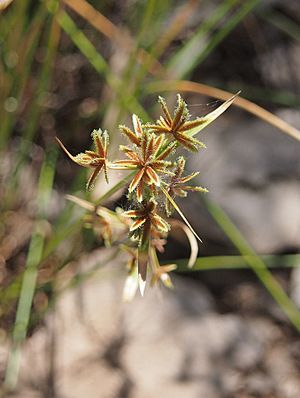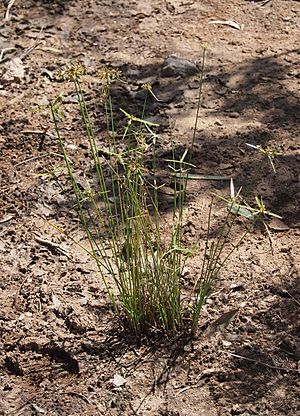Stiff-leaf sedge facts for kids
Quick facts for kids Stiff-leaf sedge |
|
|---|---|
 |
|
| Cyperus vaginatus flowers | |
| Scientific classification | |
| Genus: |
Cyperus
|
| Species: |
vaginatus
|
The Cyperus vaginatus, often called stiff-leaf sedge or stiff flat-sedge, is a type of grass-like plant. It belongs to the Cyperaceae family, which includes many sedges. This plant is originally from Australia.
Contents
What is Stiff-Leaf Sedge?
The stiff-leaf sedge is a plant that grows year after year. It has special underground stems called rhizomes. These rhizomes help the plant spread and grow new shoots. This sedge can grow quite tall, usually between 0.3 and 2 meters (about 1 to 6.5 feet) high. It grows in a clump, like a tuft of grass.
Plant Features
This plant blooms between November and February. Its flowers are green-brown. The main stems, called culms, are stiff and round. They can grow up to about 1 meter (3 feet) tall and are about 3 millimeters (0.1 inches) thick. The plant does not have regular leaves, only sheaths that wrap around the stems.
Flowers and Seeds
The flowers grow in a cluster called an inflorescence. This cluster can have between four and twelve main branches, usually shorter than 6 centimeters (2.4 inches). The small flower parts, called spikelets, are flat. Each cluster has four to fifteen spikelets. They are about 5 to 18 millimeters (0.2 to 0.7 inches) long and 2 to 2.8 millimeters (0.08 to 0.11 inches) wide. After the plant flowers, it produces a grey-brown, three-sided seed. This seed is shaped like an egg or oval and is about 0.6 to 0.8 millimeters (0.02 to 0.03 inches) long. It is about 0.5 millimeters (0.02 inches) wide.
Where Does Stiff-Leaf Sedge Grow?
You can find the stiff-leaf sedge in warm, sunny parts of Australia. It grows in subtropical areas and even in tropical regions further north.
Australian Habitats
In Western Australia, this sedge grows near creeks and streams. It likes sandy-clay soil, especially around limestone areas. You can find it in regions like the Kimberley, Pilbara, Gascoyne, Mid West, and Goldfields-Esperance. It also grows in South Australia, Victoria, Queensland, the Northern Territory, and New South Wales.
Growing Conditions
This plant grows best in full sun or partial shade. It needs soil that drains water well. If you grow it in a garden, it might need extra water during the summer.
Past and Present Locations
In Victoria, the stiff-leaf sedge used to be found in the Grampians and near Swan Hill. However, no one has collected samples from these areas since 1913. This means the plant might no longer grow there.
How People Use Stiff-Leaf Sedge
The stiff-leaf sedge has been used for a long time by people in Australia.
Traditional Uses
Indigenous Australians traditionally collect the stiff-leaf sedge from the wild. They use the strong fibers from the outer parts of the stems. These fibers are excellent for making nets and ropes.
Attracting Wildlife
This plant is also known to attract butterflies, making it a nice addition to gardens that want to support local wildlife.


